Stretch ceiling lighting in the hall: the best options and tips for choosing

Each person, when creating an interior in his home, pays special attention to the design of lighting. Currently, there are a large number of ways to organize it profitably. Today we will talk about how you can create good lighting for stretch ceilings in the hall.

Features of lighting in the living room
In living rooms, the lighting system should be organized in such a way that the entire space of the room is sufficiently provided with light fluxes. In order for the lighting in the room to be harmonious, it is recommended to select source models with the same brightness level and belonging to the same spectrum.
It is better to choose samples with approximately the same power.... In halls of a large area, zoning is often performed with the help of correct lighting. So, the brightest central light can highlight the workplace, and with more subdued lighting, separate the area intended for the rest of the household. Most often, large chandeliers act as the main light sources in living rooms. They are installed in the middle of the stretch ceiling. But for too much space, you can organize several of these medium-sized lamps and place them in accordance with the location of the hotel areas in the room.



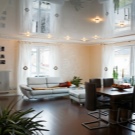


Types and choice of lighting
Currently, in specialized stores you can find a huge variety of lamps for stretch ceilings.They may differ depending on the power level. It should be remembered that such ceiling coverings are critical to increasing the temperature regime. So, the following light sources can be suitable for PVC materials:
- halogen bulbs (20 W);
- filament bulbs (no more than 40 W).
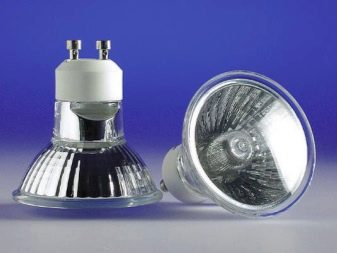
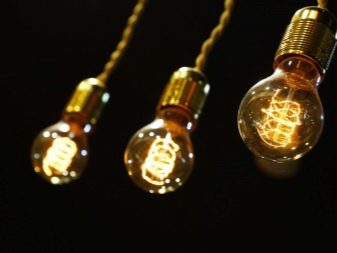
Today special satin fabrics for stretch ceilings are also produced. The following types of lamps can be suitable for them:
- incandescent lamps (60 W);
- halogen lamps (no more than 35 W);

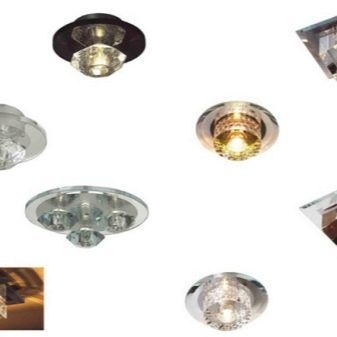
When choosing a suitable option, you should take into account the characteristics of all these light sources.
So, incandescent bulbs are the most budgetary option compared to the rest... They heat up the surrounding air, spending electricity at the same time, this can lead to heating of the stretch ceilings themselves. Halogen types of lamps, directed upwards, should be at a distance of at least 30 centimeters from the surface of the stretch coating, if their power is 30–35 watts. For less powerful models (20 W), you can make it smaller.



Currently used for stretch ceilings LED light sources, special luminous tapes. These luminaires consume relatively little electricity. If you choose to install an LED strip for your ceiling as a built-in bright illumination in the hall, then remember that for such a light source, a special power supply unit (driver) is required, located in an accessible place. LED lamps can last as long as possible. Such low-voltage type lamps are considered the most convenient and practical.
It is impossible to place them on an empty spot of ceilings without a power supply unit, since there is no ventilation at all in such places, which can lead to rapid overheating of the stretch fabrics.




A separate group includes modern energy-saving luminaire models. Today, in specialized stores, you can find models that hardly heat up, so they can be mounted at any distance from the ceiling. But inside such bulbs there are mercury vapors dangerous to humans, therefore if the source is damaged, precautions must be taken.
When decorating a lighting system in a hall on stretch ceilings, you can use either one large central LED chandelier, or combine the main bright light source with illumination or several small lamps.



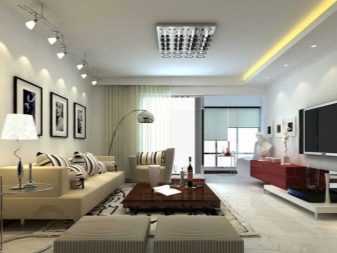
Sometimes only a few small point LED sources are installed on the cover. Sometimes spots are also mounted on the canvas. Spots are most often used for interiors decorated in modern styles. They represent a special composition made up of several spotlights, which are located on special metal brackets. All luminous elements have their own swivel cover, thanks to which you can easily turn them in the desired direction.



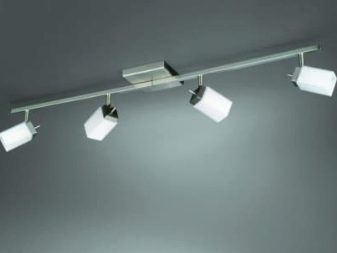
Options for the location of lamps and chandeliers
You can arrange lighting elements on a stretch ceiling in a variety of ways. Today, there are whole schemes for the placement of lamps. Options with one main central chandelier and small point sources deserve special attention. It is better to hang a large chandelier in the central part of the canvas. Several spotlights can be placed on the sides of the main source around the perimeter of the room.
If you want to make the design more original, then they can be set in the form of an arc. And you can also arrange spotlights around the chandelier in a circular direction. An interesting option would be placement of small LED sources in the form of a zigzag around one large luminaire.
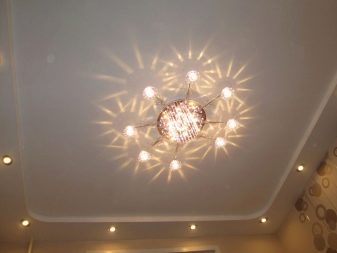


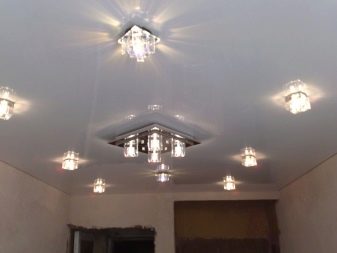
Stretch ceilings are often made in several tiers. Then in the middle of the canvas, a large chandelier is still installed, and on other tiers, bright LED or energy-saving models are mounted along the edges. Often, in addition to the main source, small lamps are installed around the perimeter of the entire room.
If the room is large, then it is permissible to make two large chandeliers at once, and several additional lamps can be mounted on the opposite side of them.
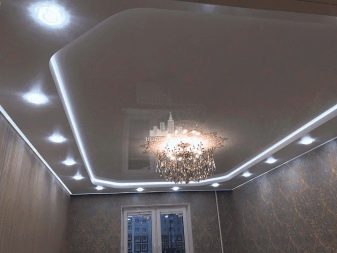
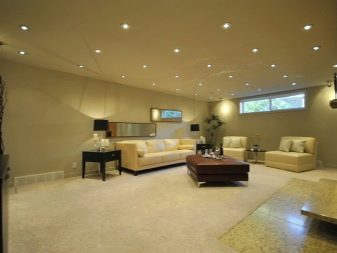

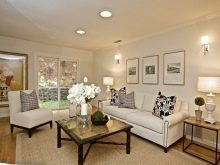

How can the space be adjusted?
Stretch ceilings, as a rule, take a little height from the room during the installation process. In small homes, this can significantly reduce room space. To make the height visually larger, you should properly organize the lighting system in living rooms. If you direct the rays emanating from the chandelier and from the auxiliary lamps towards the ceiling, then the room will appear visually higher.
This effect will be especially good when installing mirror surfaces.



If you have satin or matte stretch fabrics installed at home, then the installation of wall sconces, the light from which should also be directed upward to the ceiling, would be an excellent option. This will help create the effect of a "floating ceiling", which contributes to the visual expansion of the space. If you want to slightly adjust the geometry of your hall, then you should use LED or neon bright strips. These designs are quite flexible, so you can make products of almost any geometric shape from them.
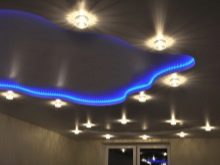
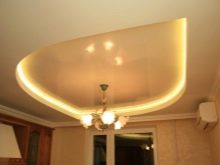

In overly elongated living rooms it is better to use the backlight for short ceilings. When the room needs to be visually stretched, it is worth installing LED lights along the long side. To beautifully emphasize multi-tiered stretch ceilings, you need to mount several LED flexible strips under the tiers at once.
If you do not highlight such transitions on the canvas with the help of lighting, then the volumetric structure will look like an ordinary solid ceiling.



Light accents
With the help of lighting in the interior of the room, you can make some design accents. So, often LED strips are used to emphasize the geometric shapes and contours of the room. They are attached with special double-sided tape. If you want to focus on the design of the lamp itself, then you can create a whole composition from several sources of non-standard shapes and bright colors.
Often, spots are used to complete the interior.... For such structures, you can easily change the direction of the arrangement, which allows you to separately highlight the various zones in the room (workplace, pieces of furniture).




Specialist recommendations
Remember that before installing the luminaires on the ceiling, it is imperative to make a small markup with the approximate placement of the elements. If you plan to make a multi-level structure in your home, then it is better to designate each tier on the general diagram... The position of the luminaires in the general plan should be noted, taking into account the distance from them to the ceiling itself.

And also do not forget that the interval between two light sources must be at least one meter. The distance from each wall should be about 60 centimeters.
It is necessary to distribute the lamps in such a way that their attachment points do not coincide with the ceiling plinths in the room. There should be a distance of at least 20-30 millimeters from them to the edge of the hole for the chandelier. When planning the placement of point light sources be sure to consider the placement of the central chandelier in the room.

It is better to install them away from it so that they play the role of auxiliary lighting in the room.
In addition, you need to take into account the characteristics of the room.So, if the room is not high, then you should not place a large chandelier on the ceiling with point light sources arranged in symmetrical rows. This can make a room feel overwhelmed and ridiculous. In low-rise rooms, only one medium-sized chandelier can be installed.
If you do not want to place only one main source, then it is permissible to hang several spots around the perimeter of the living room with plafonds deployed in different directions.



Many experts recommend paying special attention to selection of the color scheme of the stretch ceiling for the corresponding luminaires. remember, that bright and intense lighting contributes to a strong lightening of the coating, therefore, in this case, you should not select too neutral monochromatic options, it is better to give preference to dark colors. If your room is located in the shady side of the house, then it is better to choose a stretch canvas in light, light shades. Several convex spotlights with brighter lampshades will be able to emphasize the design.
An excellent option for highlighting the ceiling is LED and neon lighting. This element is perfect for both dark and light canvases. Often, it is mounted in cases where the structure has several tiers or when it is decorated in several different colors. This technique can well emphasize the design of the coating.




Interesting examples
The design with a large central chandelier, consisting of many small bulbs, will look beautiful and interesting. This design can be made in gold or silver colors.
It is better to place small round spotlights around the perimeter of the room. To make the canvas look more original, its main part can be selected in light neutral colors, and the place where the auxiliary lighting system will be located can be decorated in dark shades (brown, burgundy, blue).

Another interesting option would be the design of a multi-tiered stretch ceiling with the placement of small spotlights along the edges of each of the tiers. To highlight the volume of such a ceiling structure, you can make steps of different matching colors, and choose the light sources themselves with dark-colored lampshades.

An unusual, but beautiful option would be to decorate stretch canvases in black and white colors. In this case, the main central part is made black. A large chandelier is placed on it.
The place around the perimeter of the room is made white. There are several small LED lamps with gold or silver shades on it. It is not recommended to include additional accents of dark tones in this type of design, as this can make the interior look too gloomy.

For the location of the luminaires on the stretch ceiling, see the following video.








